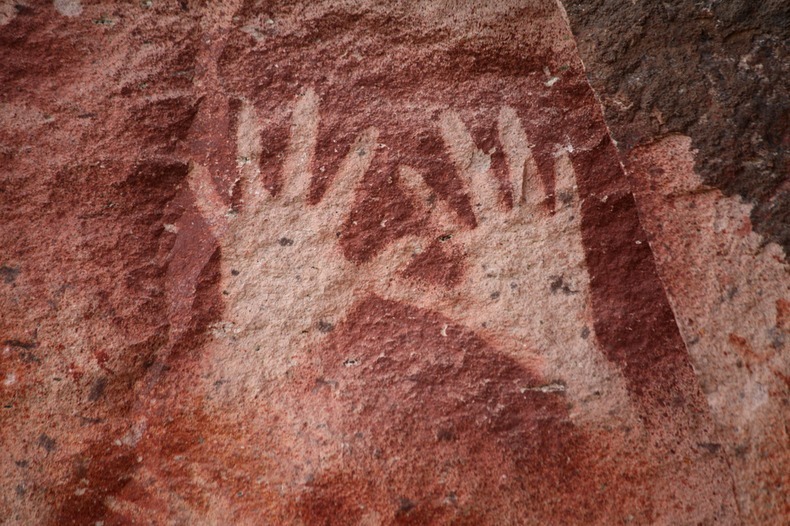Prehistoric rock paintings, handprints and stencils span all continents, and began appearing on rock walls around the world at least 30,000 years ago. But Cueva de las Manos in Patagonia contains an exceptional assemblage of cave art.
“Cueva de las Manos”, literally “the Cave of Hands”, is located in Río Pinturas, in the province of Santa Cruz, Argentina, 163 km south of the town of Perito Moreno. The cave gets its name from the cluster of stenciled outlines of human hands that appear on the cave walls. These rock paintings were made by hunter-gatherer communities estimated to have lived between 13,000 and 9,500 years ago, as determined from the remains of bone-made pipes used for spraying the paint on the wall of the cave to create silhouettes of hands.
The entrance to the cave is screened by a rock wall covered by many hand stencils. Most of the hands are left hands, which suggests that painters held the spraying pipe with their right hand. Within the rock shelter itself there are five concentrations of rock art, later figures and motifs often superimposed upon those from earlier periods. The paintings were made with natural mineral pigments - iron oxides for red and purple, kaolin for white, natrojarosite for yellow, and manganese oxide for black - ground and mixed with a binder, the nature of which is unknown.
Besides hand prints, there are also depictions of human beings, and animals such as guanacos, rheas, and felines, as well as geometric shapes, zigzag patterns, representations of the sun, and several hunting scenes. The hunting scenes portray a variety of hunting strategies with animals being surrounded, trapped in ambushes, or attacked by hunters using their throwing weapons, round stones known as bolas. Some scenes show individual hunters and others groups of ten or more men.
The paintings belong to three distinct cultures. The first human group were long-distance hunters whose main prey was the guanaco. Around 7,000 BC a second cultural level can be identified, distinguished by hand stencils. Hunting scenes are no longer found during this age. There are also some examples of stencils of the feet of the American ostrich (ñandú). This culture lasted until circa 3300 BC, when the art became more schematic and included highly stylized zoomorphic and anthropomorphic figures.
The final cultural began around 1,300 BC. Its art executed in bright red pigments, concentrated on abstract geometric figures and highly schematic representations of animals and humans. It is believed to have been the work of the historic Tehuelche hunter-gatherers who were inhabiting the vast area of Patagonia when the first Spanish traders and settlers arrived. It was the creation of vast cattle ranches that brought their way of life to an end.
























This is awful. All this graffiti in our national parks. I remember visiting Yellowstone as a teenager and it was not like this. Stupid kids these days.
ReplyDeleteI'm assuming you were just looking at the pictures when you scrolled through this article.
Deletetroll
DeleteDude try reading the article before commenting!! This are prehistoric cave paintings in Patagonia, Argentina! Not graffiti in Yellowstone park!!
ReplyDeleteI'm pretty sure he's joking
Deletethe cave pictures are amazing
ReplyDelete